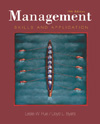 |  Management: Skills and Application, 10/e Leslie W Rue,
Georgia State University - Emeritus
Lloyd L Byars,
Georgia Institute of Technology
Managing Conflict and Stress
Chapter Summary| 1. Define conflict. Conflict is overt behavior that results when an individual or a group of individuals think a perceived need or needs of the individual or group has been blocked or is about to be blocked.
2. Discuss the useful effects of conflict. Some potentially useful effects of conflict are that it energizes people; is a form of communication; often provides an outlet for pent-up tensions, resulting in catharsis; and may actually be an educational experience.
3. Outline the stages of conflict development. The stages of conflict development are latent conflict, perceived conflict, felt conflict, manifest conflict, and conflict aftermath.
4. Name the five major types of conflict based on the entities involved. The five major types of conflict based on the entities involved are intrapersonal, interpersonal, intergroup, organizational, and political.
5. Name five methods of resolving interpersonal conflict. There are five general methods of resolving interpersonal conflict: (1) withdrawal of one or more of the participants; (2) smoothing over the conflict and pretend it does not exist; (3) compromising for the sake of ending the conflict; (4) forcing the conflict to a conclusion through third-party intervention; and (5) forcing a confrontation between the participants in an effort to solve the underlying source of conflict.
6. Name and briefly discuss one method of positively managing conflicts created by diversity in the workplace. One method for positively managing conflicts created by diversity in the workplace is organizational diplomacy. Organizational diplomacy is based on a proactive, unifying approach to diversity, as opposed to a reactive and superficial approach.
7. Define stress. Stress is the mental or physical condition that results from a perceived threat of danger (physical or emotional) and the pressure to remove it.
8. Define burnout. Burnout is a condition that occurs when work is no longer meaningful to a person.
9. Outline the basic elements of a violence-prevention program. The basic elements of a comprehensive violence-prevention program are a written policy statement communicating a clear commitment to promoting a workplace safe from violence; a management response team; a meaningful reporting and response mechanism; clear standards of behavior; a wide array of other security, employment, legal, and administrative practices; and a system of periodic employee training covering violence-prevention issues.
10. Explain the three basic types of employee assistance programs. In one type of EAP, diagnosis and treatment of the problem are provided directly by the organization. In a second type, the organization hires a qualified person to diagnose the employee's problem and then refers the employee to a proper agency or clinic for treatment. The third and most common type employs a coordinator who evaluates the employee's problem only sufficiently to make a referral to the proper agency or clinic for diagnosis.
11. Explain wellness programs. Wellness programs are company-implemented programs designed to prevent illness and enhance employee well-being. |
|



 2003 McGraw-Hill Higher Education
2003 McGraw-Hill Higher Education